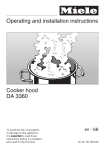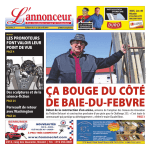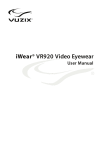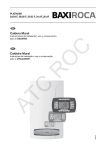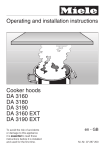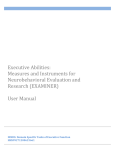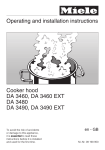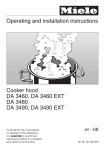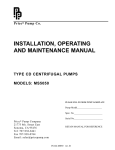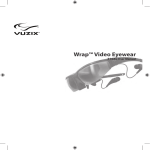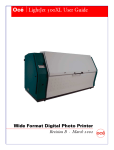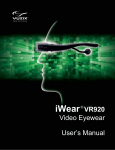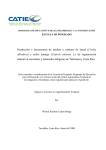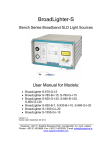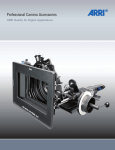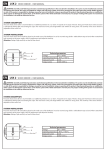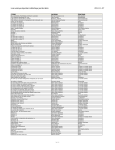Download BME 4900 Final Report - University of Connecticut
Transcript
Final Report Integrated Virtual Reality and Head Movement Tracking System Team #7 Jennifer Chaisson Ryan Manning Eleni Kursten 12/9/2011 Client: Dr. John D. Enderle University of Connecticut [email protected], 860-486-5521 1 Table of Contents Abstract ........................................................................................................................................... 3 1. Introduction ................................................................................................................................. 4 1.1 Background ........................................................................................................................... 4 1.2 Purpose of the Project ........................................................................................................... 4 1.3 Previous Work Done by Others ............................................................................................ 5 1.3.1 Products.......................................................................................................................... 5 1.3.2 Patent Search Results ..................................................................................................... 5 1.4 Map of the Rest of the Report ............................................................................................... 5 2. Project Design ............................................................................................................................. 6 2.1 Introduction ........................................................................................................................... 6 2.2 Alternative Design 1 ............................................................................................................. 6 2.3 Alternative Design 2 ............................................................................................................. 7 2.4 Alternative Design 3 ............................................................................................................. 8 2.5 Optimal Design ................................................................................................................... 10 2.5.1 Objective ...................................................................................................................... 10 2.5.2 Virtual Reality Glasses ................................................................................................ 11 2.5.3 Head Tracker ................................................................................................................ 13 2.5.4 Visual Stimuli Tests ..................................................................................................... 15 2.5.3 Headphones and Sound Production ............................................................................. 18 2.5.4 Auditory Stimuli Tests ................................................................................................. 19 2.5.5 User Interface/ iPod Touch Application ...................................................................... 20 3. Realistic Constraints ................................................................................................................. 20 3.1 Health and Safety ................................................................................................................ 20 3.2 Manufacturability................................................................................................................ 21 3.3 Ethical ................................................................................................................................. 21 3.4 Environmental ..................................................................................................................... 21 3.5 Sustainability....................................................................................................................... 22 3.6 Social/Political .................................................................................................................... 22 4. Safety Issues.............................................................................................................................. 22 5. Impact of Engineering Solutions .............................................................................................. 23 2 6. Life-Long Learning ................................................................................................................... 24 7. Budget and Timeline ................................................................................................................. 25 7.1 Budget ................................................................................................................................. 25 7.2 Timeline .............................................................................................................................. 25 8. Team Members Contributions to the Project ............................................................................ 28 8.1 Jennifer Chaisson ................................................................................................................ 28 8.2 Eleni Kursten ...................................................................................................................... 29 8.3 Ryan Manning ..................................................................................................................... 29 9. Conclusion ................................................................................................................................ 30 10. References ............................................................................................................................... 30 11. Acknowledgements ................................................................................................................. 30 12. Appendix ................................................................................................................................. 31 12.1 Updated Specifications ..................................................................................................... 31 12.2 Purchase Requisitions ....................................................................................................... 32 3 Abstract This virtual reality and head movement tracking system for auditory and visual stimuli is being designed so that our client, Dr. John D. Enderle, can further pursue his goal of building a portable device that can diagnose mild traumatic brain injury. Our virtual reality system will create a totally immersive testing environment that will display auditory and visual stimuli. The head tracking aspect of the design will collect the real time XYZ head positions of the subject. A user-interface will initiate the auditory and visual stimuli tests as well as store the subject’s head positions for each test. Our design will incorporate mechanical, electrical, and software components to create a portable lightweight, weatherproof, battery powered device to satisfy the needs of our client. Most of our components will be off the shelf, keeping our budget close to 1000 USD. 4 1. Introduction 1.1 Background The client, Dr. John Enderle, is a researcher and professor at the University of Connecticut and has spent the past thirty years focusing his research on rapid eye movements and their respective neuronal activities. Dr. Enderle has three main categories of his research: eye movement data collection, muscle movement data collection, and neuron modeling. His research has provided him with substantial findings to proceed to the design phase. His work has progressed to the point where he believes that he can determine whether or not a person has suffered mild traumatic brain injury based on their results from a combination of eye movement tests. Through the use of his knowledge of the brain and his neuron model he believes that he can also determine where in the brain the injury occurred. Ultimately, he would like to build a portable, lightweight virtual reality device that would run a series of visual and auditory stimuli tests. The device would track the eye movements of the subject (using a high speed camera or infrared camera) in response to the stimuli to determine the diagnosis. It would also track the subject’s head position in real time to obtain more accurate data of the subject’s eye movements. This device would have a huge impact on society; close to one million Americans suffer a concussion every year. The device would be ideal for sidelines of contact sports and on the battlefield of the military where players/soldiers often experience concussions. This is also a device that could be placed in every emergency room in the country to allow for more efficient diagnosing of mild traumatic brain injuries. Too often, concussions are not detected or are ignored, leaving that person at severe risk for future, longer lasting traumatic brain injuries. Dr. Enderle is in the preliminary stages of his idea and has asked that we design and build an integrated virtual reality device that can run the visual and auditory stimuli, as well as track the head movements of a subject. Dr. Enderle would like the device to have a user-interface that will initiate the tests as well as store the head movement data from each test for future analysis. 1.2 Purpose of the Project As was previously discussed, the virtual reality and head movement tracker system will be used as part of the client’s future project to diagnose mild traumatic brain injury. The virtual reality system will be portable, weatherproof, and capable of running several visual and auditory stimuli tests. The use of virtual reality will allow the subject to run the tests without any outside visual distractions for more accurate data. The visual stimuli will provide accurate targets for rapid eye movements. The auditory stimuli will also provide targets for eye movements and in the future the data from the auditory eye movements will help the client determine the location of the injury suffered within the brain. The head movement tracker will be integrated into the virtual reality device and will record the real time XYZ positions of the test subject’s head while he/she is taking the stimuli tests. The head movement tracking will ultimately be used to determine a more accurate measurement of the test subject’s eyes movements. Our device will be the first physical product of the client’s ultimate project. The completion of our device will provide the client with a solid foundation to continue improving and adapting his design for an all-encompassing device that can detect mild traumatic brain injuries. 5 1.3 Previous Work Done by Others 1.3.1 Products There is a high demand in the military and in sports such as football and hockey for a portable device that can accurately diagnose concussions on the sidelines. While there are a handful of concussion tests on the market, most of them require a quiet room and run lengthy cognitive tests that require in depth baseline tests. Michelle LaPlaca, an assistant professor in Biomedical Engineering at Georgia Tech and Emory University, and David Wright, assistant director of Emory University's Emergency Medicine Research Center, are working on a product called DETECT (Display Enhanced Testing for Concussions and mTBI system). DETECT is a virtual reality system that runs three types of neuropsychological tests that measure the function of several parts of the brain as it attempts to perform the tests. The test takes about seven minutes and includes a totally immersive test environment through the use of the virtual reality system, which also includes ear pieces that give the test subject instructions. The test subject responds to the tests through the use of a controller. While this DETECT does use the virtual reality aspect, the client, Dr. Enderle, hopes to be the first researcher in his field to diagnose mild traumatic brain injury through the use of eye movements. 1.3.2 Patent Search Results The client is the first in his field to provide sufficient evidence using data that fits into an actual mathematical model for eye movements to diagnose mild traumatic brain injury from eye movement tests. Therefore, his idea for a portable device that diagnosis mild traumatic brain trauma based on a high speed camera’s ability to track eye movements is an original idea. Although other concussion tests do exist, there aren’t any patents on a portable device that runs both auditory and visual stimuli. Patent application 12/931,881 is a stationary non-portable design that tracks a subject’s gaze as they follow a moving target on a computer monitor for concussion screening. Patent application 12/780,355 is a design for a portable user-interface device that uses electrodes to track a subject’s eye movements. Patent application 11/503,579 is a semi-portable virtual reality design for mild traumatic brain injury detection; however, this patent application is designed for the use of cognitive response tests. 1.4 Map of the Rest of the Report Thus far, background information of the client and our project has been presented, as well as the purpose of our project. Section 2 will discuss our three alternative designs and it will also go into detail on our optimal design as well as our reasons for selecting our optimal design. Section 2 will have several subsections detailing specific components of our optimal design. Section 3 will elaborate on the realistic constraints of our project, including the social/political, ethical, environmental, manufacturability, and health and safety constraints. Section 4 will further elaborate on the safety issues involved with our project, and the fifth section will discuss the impact of engineering solutions. The sixth section will provide information on the life-long learning that we have earned through the process of designing our project. The following section will provide the reader with our most up-to-date budget and expenses as well as the estimated timeline of tasks that will need to be completed towards the completion of our project. Section 8 will give a brief summary of the work that each team member has completed thus far. The conclusion for this report will be given in the ninth section. Sections 10, 11, and 12 will be the 6 references, acknowledgements, and appendix. The appendix will be divided into two subsections with the first being our updated specifications and the second being the purchase requisitions that we have submitted thus far. 2. Project Design 2.1 Introduction The design process for our device was a long process that spanned several weeks. We first created three possible designs for our device (Subsections 2.2 – 2.4). Then we chose an optimal design for which we could begin ordering parts and building. The optimal design that we decided to use is discussed in detail in the Subsection 2.5. We chose this design for numerous reasons, with the most important being the portability of this design. We decided to take the best aspects of the three alternative designs and incorporate them into one optimal design. We believe that the design we’ve chosen will exceed the original expectations of the client. Our device will be extremely portable, lightweight, and will be tremendously easy to use for the needs of the client. 2.2 Alternative Design 1 Our first design is a gaming system inspired mechanism that utilizes the TrackIR 5, which is a premium head tracking device that is used as an addition for gaming. The device sets the user’s head up to a screen which immerses the user completely and allows them to link their head movement in the game to their actual head movement in space. The view is three dimensional for the user. The system can be used for the computer, so it is also an addition to a computer device. This system is unique because it gives the user “6 degrees of freedom”. The head is able to move in 6 different directions and the TrackerIR can support all of them, making it unique to other tracking devices. Figure one, shown below, is an image of the TrackerIR. Figure 1: TrackerIR System 7 This system is perfect for the head tracking and is ideal because it already has a screen built in, which will be used to display the eye movement tests. The device will be connected to a portable computer that has the visual stimuli tests installed on it, and instead of showing a game on the screen the user will see the eye tests. The head tracker will very accurately track the head movements of the user as their eyes follow the test. This design will allow the user to very easily track the head in all directions with minimal discomfort. In addition to the eye and head tracking device, the auditory system will be installed on the TrackerIR. The auditory stimuli tests will use headphones and sound recorded using a software program developed by Longcat 3D Audio Technologies. This program simulates how humans localize sound in 3D space. It has an easy to use interface where the user selects where the sound will be coming from on a 3D plane. When listening through headphones the sound seems to be coming from a different location around the room. We will place the sound around the users head 20 degrees in each direction to develop the audio tests. The eye movement result will be stored in a similar fashion using the TrackIR. 2.3 Alternative Design 2 The second design is targeted at the portability aspect of our system. This will be accomplished by the use of the Wrap 1200VR virtual reality glasses from Vuzix as seen in Figure 2. Usually used for watching movies on long plane rides, or for the use in video games, the glasses are ideal for our application. These glasses are 3-D capable, have a screen resolution of 1280 x 720 pixels, and also have a head tracking feature that allows for three degrees of freedom. The glasses also provide the user with a 35-degree diagonal field of view, which will allow the test to incorporate eye movements of larger degrees. They are designed so that they fit over most prescription glasses, and are adjustable for variable eye separation distances. This will allow a wide variety of people to use the device. A storage device will be attached to the glasses, on which the visual test will be stored and run from. The head is able to move in six degrees of freedom, so the limitation of only being able to track three degrees of freedom is a disadvantage to this design when compared to the first design. The major advantage however, is the portability that these glasses give the system. Figure 2. Vuzix Wrap 1200VR 8 To deal with the visual disruptions that can occur while wearing glasses, the Wrap Lightshield will be used. This shield attaches to the glasses and helps block external light around the forehead, and cheekbone areas. Since the subject will most likely be dazed after a suspected traumatic brain injury, the blocking of external light will allow them to be more immersed in the virtual reality. This in turn will make the test run smoother and provide results faster. The auditory test will consist of at least 20 small circular speakers. The speakers will be arranged in a way that allows the auditory test to mimic the visual test. This means that they will be set up so that the subject can follow the auditory stimuli 20 degrees in any direction with their eyes. The distance the subject sits from the speaker set up will affect the amount of degrees they can follow the stimuli with their eyes. To solve this, a specific distance will be established for all subjects. Since all different eye movements will be tested, there will need to be speakers relatively close to one another to allow for cascading sound from one speaker to the next. Using this arrangement will hopefully allow the auditory test to mimic the visual test as closely as possible. 2.4 Alternative Design 3 A third option for the design of our Integrated Virtual Reality and Head Movement Tracking System will allow the virtual reality display to be incorporated into a variety of head gears. The client would ultimately like his device for detecting mild traumatic brain injury to be used in applications such as the National Football League, the National Hockey League, the military, etc. When it comes to the NHL and NFL, many teams try to disclose information from the media with regards to the injuries of their players. Especially during playoffs, opponents sometimes purposely try to place as many hard hits as possible on players they know are injured. For this reason, it might be beneficial for a team to try to disguise that one of their players is on the sidelines being tested for a possible concussion. That is why our third design allows the virtual reality system to be incorporated into any helmet that can also include a visor. Similar to the images shown in Figure 3, many professional athletes wear tinted visors to reduce glare. Attaching the virtual reality device behind a mirrored visor might conceal the fact that a player is actually taking a concussion test. Figure 3. Superstar professional athletes Alex Ovechkin (NHL) and Ladainian Tomlinson (NFL) 9 The virtual reality device that will be used for this design will be the Wrap 310XL Eyewear from Vuzix (Figure 4). The ear pieces and speakers that are built into the 310XL will be removed and a light-blocking add-on will be used. The device will then be attached to the inside of a mirrored visor. The inside of the visor will be painted black to further block out unwanted light. All hockey helmets are adjustable to accommodate many head sizes; however, football helmets are not. Therefore, removable foam pads will be used inside a football helmet to assure that the helmet fits the test subject properly. As was previously mentioned, this design is ideal for multiple situations and applications. An example of how this design could be effective in disguising the virtual reality stimuli tests is given in Figure 5, which displays an image of a homemade flight simulator with the eyewear incorporated into the visor of a helmet that was made to look like a fighter pilot helmet. Figure 4.Wrap 310XL Eyewear from Vuzix Figure 5. Disguising eyewear using a visor and a helmet for flight simulation tests 10 A Wii remote and sensor bar will be used to track the head movements of the person wearing the head gear. The Wii sensor bar contains multiple infrared sensors on both sides. Our design will place at least one infrared sensor on either side of the helmet visor. The Wii remote will be fixed a distance away from the test subject. Data acquisition software will be used to obtain the real time XYZ positions of the test subject’s head, while LabVIEW will be used to plot the acquired data. The audio stimuli test setup will be the same as the setup discussed in our second alternative design. Figure 6. Wii remote and sensor bar Furthermore, since the entire system will be inside of a helmet it will be hard to access any buttons on the system. To account for that a user interface system must be incorporated in to the design. To do this we will run all of the tests from an IPod touch or alternative music/video storage device. The device will store the visual tests in a video format and the auditory tests in an mp3. This will allow the user to easily access the tests and view them in front of their eyes. The glasses have the capability to connect to an IPod touch or IPhone, so it will be simple to attach the device to the player. 2.5 Optimal Design 2.5.1 Objective The main component of our device is the virtual reality glasses that will serve as the virtual display screen for the visual and auditory stimuli tests. For our optimal design, we’ve decided to use the Wrap 1200VR video eyewear from Vuzix. We chose this product because it is very lightweight and portable, has excellent aesthetics, it has superior specifications for the virtual display screen, it is extremely customizable so that anyone can use it, and because it comes with the Wrap Tracker 6TC. The Wrap Tracker 6TC is a built-in head movement tracker. The Wrap 1200VR is truly the leading technology in its class. The Wrap 1200VR eyewear will be connected to an Apple iPod Touch by a cable. The iPod Touch will initiate a series of visual and auditory stimuli tests. The visual stimuli tests will be saved as slideshows of stimuli images and will be displayed on the virtual screen of the Wrap 1200VR glasses. The auditory stimuli will be produced by in-ear headphones connected to the virtual reality glasses. The auditory stimuli will be programmed using 3-D sound localization technology and the tests will be saved as sound files on the iPod Touch. The auditory stimuli 11 tests may also simultaneously display images on the virtual reality glasses. The Wrap Tracker 6TC will be used to track the head movements of the subject during both the auditory and visual stimuli tests. Figure 7 displays a flow chart of the sequence of events during both the auditory and visual stimuli tests. Visual stimuli tests initiated by iPod Touch VR Glasses display visual stimuli tests Headphones output sound stimuli Wrap Tracker 6TC tracks head positions Head position data stored on iPod Touch Auditory stimuli tests initiated by iPod Touch Figure 7: Flow chart showing the sequence of events during the visual/ auditory stimuli tests 2.5.2 Virtual Reality Glasses The product that we’ve chosen to use for our virtual reality display is the Wrap 1200VR glasses from Vuzix. Vuzix is one of the leading companies in the design of virtual reality virtual reality eyewear and the Wrap 1200VR is their most recently released product. We chose this product over our alternative options because the Wrap 1200VR is superior in almost every manner. We need a product that meets all of our specifications and the Wrap 1200VR is the ideal choice for our device which will be explained in detail below. 12 Figure 8: Wrap 1200VR glasses When we were choosing a product to display our visual stimuli tests, our biggest concern was the portability/weight of the product; the Wrap 1200VR weighs less than 3 ounces. Our second big concern was the size of the display screens. The virtual display we want needed to be large enough that we could stimulate eye movements of up to twenty degrees in the horizontal direction and 15 degrees in the vertical direction. The Wrap 1200VR glasses create a 75 inch virtual screen as viewed from ten feet away (approximately three meters). The virtual screen has a 16:9 widescreen aspect ratio and a 35 degree diagonal field of view. Therefore, the Wrap 1200VR virtual screen gives a 17.5 degree vertical field of view and over a 30 degree horizontal field of view, which is ideal for our visual stimuli tests. The Wrap 1200VR contains twin highresolution 852 x 480 LCD displays. The glasses can support input resolutions up to 1280 x 720. These differences in screen resolutions will play a part when it comes to defining the location of individual stimuli on the virtual screen versus the computer screen. One of the major appealing factors of the Wrap 1200VR glasses is that they are very customizable. Basically, the glasses do not discriminate and anyone can use them. They have 24bit true color (16 million colors) and on-screen display adjustment with adjustable brightness, hue, contrast, and color saturation. The glasses can support 2-D and 3-D formats, however, we will only be concerned with the 2-D format. The glasses can be worn over prescription eyeglasses and have individual right and left eye focal adjustments (diopters) of +2 to -5. The separation between the two screens can also be adjusted. Furthermore, the Wrap 1200VR glasses have an adjustable hypoallergenic nose-piece and Accutilt® hinge angle adjustment for the optimal viewing angle. The Wrap 1200VR glasses are compatible with several accessories. We will be using the Wrap™ Lightshield (shown below) to help completely immerse the subject into the tests by blocking out any undesired light. Also, once we have tested the auditory and visual stimuli tests using a computer we will be creating an iPod Touch application that will initiate and run the tests, as well as save and store the head position data during the tests. That being said, Vuzix offers and optional connection cable for the glasses to connect to several versions of iPods, including the iPod Touch. We will be ordering this cable, which comes in a combo pack that also includes a battery pack for the glasses. This is ideal for us because it helps us maximize the portability of our device. 13 Figure 9: Wrap™ Lightshield The biggest asset of the Wrap 1200VR video eyewear to our project is its ability to track head movements. Originally, we had planned on using the Wii remote and sensor bar to collect the head movement data. However, the Wrap 1200VR comes with a built-in head tracking system called the Wrap Tracker 6TC. The Wrap Tracker 6TC will be discussed in detail in Section 1.2.2. The box contents that are included along with the Wrap 1200VR glasses are a Wrap VGA adapter, the Wrap Tracker 6TC, detachable premium quality noise-isolating earphones, three sizes of noise isolation earphone inserts, the manual, warranty and safety instructions, and a soft carrying case. The total price of the Wrap 1200VR video eyewear and box contents is $599.99. The price of the Wrap™ Lightshield is $19.99. The cost of shipping both the video eyewear and the lightshield is $16.68, bringing the total cost to $636.66. Figure 10: Vuzix Product Box 2.5.3 Head Tracker As stated in section 1.2.1 the Wrap 1200VR glasses offer us head movement tracking abilities. The glasses come bundled with Vuzix’s Wrap Tracker 6TC, as seen in Figure 11. The Wrap Tracker 6TC is Vuzix’s newest and most advanced head tracking technology available. It uses gyroscopic sensors and multiple magnetometers to calculate the movement and positioning of the head in real time. Gyroscopic sensors measure orientation based on conservation of angular momentum. Many different types of magnetometers exist; the ones used in the Wrap Tracker 6TC are vector magnetometers. The vector magnetometers work by utilizing the magnetic field of the earth in order to complete calculations. Since earth’s magnetic field at any point is a three dimensional vector, has both a magnitude and directions, it is possible to calculate changes in earth’s magnetic field vector from a previous vector. Magnetic fields from other objects, such as large metallic objects and magnets, can affect the accuracy of magnetometers in the Wrap Tracker 6TC. This means that if the glasses are moved into a different environment they must be calibrated to the surrounding conditions accordingly. 14 Figure 11: Vuzix Wrap Tracker 6TC Vuzix provides a free download of their VR Manager with the Wrap Tracker 6TC in order to simplify and speed up calibrations. This software kit provides calibration for yaw, pitch, and roll of the head, but not X-Y-Z axis movements. In order to get the X-Y-Z axis movements the Vuzix software development kit (SDK) was downloaded. This kit provides functions and descriptions of how to extract the needed X-Y-Z head tracking data from the Wrap Tracker 6TC. The code is in the language of C++ and a demo program is provided that can be modified in order to allow us to extract and save the data required. In addition to calibrating the magnetometers for different environments, the gyroscopic sensors must be zeroed before each use to ensure accuracy. This can be done by implementing automatic zeroing when the device is first turned on. Different environmental calibrations may also be saved and implemented in an auto calibration setting to speed up boot up time. These calibration improvements can be saved as a script we create that runs automatically whenever the device software is opened. The gyroscopic sensors and magnetometers allow the Wrap Tracker 6TC to provide six degrees of freedom in head movement tracking. That is, the head can move in six distinct ways, which include yaw, pitch, roll, and X-Y-Z axis movements. Figure 12 shows a visual representation of the six degrees of freedom of the head. Yaw, orange in Figure 12, refers to the ability to rotate your head to the left and to the right around a vertical axis. Roll, green in Figure 12, refers to the ability to tilt your head laterally to the left and right. Pitch, light blue in Figure 12, is the movement of tilting you head forward and backwards. X-Y-Z movements determine what position your head is in three dimensional space. Being able to acquire data from these head movements will be crucially effect our ability to make eye movement corrections. As the head moves in the direction of stimuli, the degree to which the eyes have to move to see the stimuli is greatly decreased. Since eye movement data is the major concern of our client, we would like to make be able to make corrections based directly on the degree to which the head moves toward the stimuli. 15 Figure 12: Six Degrees of Freedom The head tracking data created by the Wrap Tracker 6TC will need to be transformed into comprehensible information. The software development kit that was downloaded from the Vuzix website will allow us to extract the raw data from the Wrap Tracker 6TC. This data will then be imported into LabView for further analysis. The methods provided by the kit will provide us with the raw data, but this data will need to be verified. This will be accomplished by comparing it to the Microsoft Kinect’s head tracking data. The Kinect boasts a color video graphics array (VGA) video camera, an infrared depth sensor and a multi-array microphone. Microsoft also provides a software development kit with methods that allow users to customize the revolutionary hardware to fit specific applications. The Kinect will be configured to track only the head of a subject by placing markers on certain parts of the head instead of placing multiple markers over their entire body. This will provide skeletal movement of only the head and not the entire body. A nice feature of the Kinect is that you are able to interface with it using LabView. This will simplify the job of comparing the Wrap 6TC data to the Kinect’s data. Both sets of data will be displayed on an X-Y-Z (three dimensional) graph in LabView for ease of comparing and contrasting. 2.5.4 Visual Stimuli Tests Our client, Dr. Enderle, would like the visual stimuli tests to be set up the same way as the ones he uses in his research lab for collecting eye movement data. Stimuli will be required for various degrees both positive and negative, horizontally and vertically relative to the center of the display screens. The images containing the stimuli will be built in Windows Paint on a computer. The images will then be transferred onto an iPod Touch which will run the desired test and the test will be displayed on the virtual reality glasses. Therefore, it is important to determine the exact pixel location for each stimulus to create the desired target degree movement. This required some trigonometric equations involving the dimensions of the display screens and the virtual distance that the user is from the display screens. Since the glasses create a virtual reality display the virtual dimensions of the display screens will be used. On their website, Vuzix states that looking into the Wrap 1200VR is equivalent to watching a 72 inch screen from 10 feet away. The pixel locations for the stimuli when building them on the computer using both the 4:3 and 16 16:9 aspect ratios are shown in Tables 1 and 2. Due to the limitations of the dimensions of the virtual display screen fewer stimuli will be achievable in the vertical direction, especially when the glasses are in the 16:9 aspect ratio mode. Degree mm from Center Pixels from Left Pixels from Top 0 0 640 360 1 53 687 325 2 106 733 289 3 160 780 254 4 213 827 218 5 267 874 182 6 320 921 146 7 374 968 111 8 428 1016 74 9 483 1063 38 10 537 1111 2 11 592 1160 - 12 648 1208 - 13 704 1257 - -1 -53 593 395 -2 -106 547 431 -3 -160 500 466 -4 -213 453 502 -5 -267 406 538 -6 -320 359 574 -7 -374 312 609 -8 -428 264 646 -9 -483 217 682 -10 -537 169 718 -11 -592 120 - -12 -648 72 - -13 -704 23 - Table 1. Horizontal and vertical pixel locations for the visual stimuli using a 4:3 aspect ratio. Degree mm from Center Pixels from Left Pixels from Top 0 0 640 360 1 53 683 317 2 106 726 275 3 160 769 232 4 213 812 189 17 5 267 855 147 6 320 898 104 7 374 942 61 8 428 985 17 9 483 1029 - 10 537 1073 - 11 592 1118 - 12 648 1162 - 13 704 1207 - -1 -53 597 403 -2 -106 554 445 -3 -160 511 488 -4 -213 468 531 -5 -267 425 573 -6 -320 382 616 -7 -374 338 659 -8 -428 295 703 -9 -483 251 - -10 -537 207 - -11 -592 162 - -12 -648 118 - -13 -704 73 - Table 2. Horizontal and vertical pixel locations for the visual stimuli using a 16:9 aspect ratio. Once the stimuli images have been built they will be stored on an iPod Touch in a series of visual tests. The tests for the visual stimuli will be very similar to those run for the auditory stimuli tests. The visual tests will be composed of three different categories of tests, and they will all be run on an iPod Touch and displayed on the virtual reality screens of the Wrap 1200VR glasses. A cable will be used to connect the iPod Touch to the virtual reality glasses. The virtual reality glasses can support an input display resolution up to 1280 x 720. The client would like the stimuli separations to be based on degrees, relative to the user, with zero degrees being the very center of the virtual reality glasses (see Tables 1 and 2). The first category of visual stimuli tests is called goal-oriented saccades. During these tests, the subject will have to track the stimuli with his/her eyes. The stimuli will move instantaneously from one position to the next, and may move in the horizontal or vertical direction or any combination of the two (360°). A second type of goal oriented tests will be smooth pursuit eye movements. During these tests the stimuli will transition in a gradual manner from one position to the next. The subject will have to track the stimulus as it moves across the screen. Once again, the stimuli may move in any direction. The second category of tests will be designed for anti-saccades. To begin these tests a stimulus will be displayed in the center of the screen (zero degrees). The stimulus will then move instantaneously in either a horizontal or vertical direction. The subject will be required to move his/her eyes in the direction opposite of the direction of the stimulus change. In other words, if 18 the stimulus begins at zero degrees and moves to the right ten degrees, then the subject will have to aim his/her eyes left ten degrees. The final category of tests will be memory based tests. Many current concussion tests use memory response techniques to diagnose brain trauma. During these tests the subject will be shown a sequence of eye movements, and will then have to repeat the sequence from memory while looking at a blank screen. 2.5.3 Headphones and Sound Production In order to keep the system extremely portable, three dimensional positional audio will be used for the auditory stimuli tests. Three dimensional positional audio produces sounds as heard in three dimensional space. We will use software created by Longcat 3D Audio Technologies that utilizes state of the art algorithms that incorporate head transfer related functions (HRTF’s). This software simulates the way humans localize sound in three dimensional space by using the head related transfer functions. The head related transfer functions take into account the interaural time difference and the interaural intensity difference. The interaural time difference is the time difference between when one ear hears sound compared to when the opposite ear hears the same sound. The interaural intensity difference is the difference in sound intensity heard by both ears from the same sound. These processes are shown in figure 13, below. This is a two dimensional representation of how humans localize sound. The thicker lines coming from the speakers to the ears represent higher intensity sound and the shorter lines to the ears represent smaller amount of time for the sound to reach the ear. It can be seen that sounds produced on the left side reach the left ear in a shorter amount of time and with more intensity than when the same sound reaches the right ear. Figure 13: Interaural Time and Interaural Intesnity Differences Visualization The software is in the form of a plugin that can be used with most audio hosts such as Pro Tools, Ableton, Logic, Reason, and many more. The plugin lets the user define parameters, such 19 as the size of the virtual room the sound is to be produced in, the type of sound input being used, and the sound’s three dimensional position within the virtual room. It also provides the user with a three dimensional visual interface, shown in Figure 14 below, that shows the relative distance of the sound(s) in the virtual room with respect to a central position. The central position will ultimately be the subject’s ears, and the sounds will be positioned in reference to them. The auditory tests can be created by defining positions for the sounds to be produced from in the specified virtual room. The virtual room can also be altered if different reverb and cross talk affects are desired based on testing. Figure 14: Longcat H3D Plugin Visual Interface The ability for humans to localize sound is limited due our physiological makeup. The best three dimensional positional audio software is still limited by sound localization errors. The average localization errors are around 9-10° in elevation and 5-6° azimuth. In order to attempt to counter this effect, a graduate student in Dr. John Enderle’s lab is constructing a large scale speaker matrix to do testing with. Our group plans on using the Biopac system to test the sound localization errors and compare them to the graduate student’s data. The result will hopefully be a solution to the sound localization problem. 2.5.4 Auditory Stimuli Tests The auditory stimuli tests will be the same as the visual stimuli tests. There will be the three categories of tests: 1. Goal-oriented saccades, 2. Anti-saccades, and 3. Memory-based saccades. However, whereas the visual tests will run the stimuli from an iPod Touch and display them on the virtual screen of the glasses, the auditory stimuli tests will be run from the iPod Touch, but the sound will be produced through in ear headphones connected to the virtual reality 20 glasses. As was discussed in the previous subsection, 3-D sound localization technology will be used to program the auditory stimuli tests. First we will need to identify how to localize sounds at specific (relative) degrees in front of a user wearing headphones using the head related transfer functions on a computer. Once the sounds have been created a collection of the required sounds will be put together to create each auditory stimuli test. Each test will then be saved as sound file and transferred to the iPod Touch. Once on the iPod Touch the auditory stimuli tests will be initiated and run using an application that we will have programmed. In addition to using the sound as stimuli for the auditory tests, the client has also expressed interest in using visual guides as a reference to help the subject during the initial stages of the auditory tests. Therefore, we will have to program the iPod Touch application to simultaneously play the sound tests and display images on the virtual reality glasses. 2.5.5 User Interface/ iPod Touch Application In order to make the device as portable as possible the user interface needs to be lightweight and compact. This is why we have chosen to use the Apple iPod Touch as the user interface for the device. The iPod Touch will allow us to have a portable interactive user interface that measures 4.4 inches x 2.32 inches x 0.28 inches and weighs a mere 3.56 ounces. The Wrap 1200VR glasses come with an optional 30-pin connection that allows it to connect to a host of different Apple products. Apple also has a software development program, available free of charge, that allows users to create applications for the iPod Touch. This program will be used to create an application that acts as the user interface of the device. It will hold the visual and auditory stimuli tests, as well as run them on the glasses. The head tracking data will be saved locally on the iPod Touch itself. The data can then be downloaded to a host computer at a later time for further analysis. 3. Realistic Constraints This project will follow all proper engineering protocol and standards. Ideally the design will be sound and provide the user with the product that they desire. Furthermore, the design practices will be unique to the team and incorporate collective thinking and innovation. The optimal design will have a few realistic constraints that must be considered in the design. These constraints fall under several broad categories outlined and described in detail below. 3.1 Health and Safety Since the design of this project requires the patient to place a headgear on to them which includes the glasses, while they are possibly suffering head trauma, it will be important for the design to ensure that the patient’s health and safety is not compromised any further when using the device. To ensure this the design will be as lightweight as possible since the patient may be experiencing headaches from the injury. Since the design incorporates the Vuzix glasses the weight of those cannot be adjusted, however, those have been designed for optimal use and are only 3 ounces in weight. Fortunately, using headphones as our sound source for the auditory stimuli tests will not add any significant weight as they are extremely lightweight. 21 Furthermore, the eye test that is run with flashing lights on the screen will be mindful of the fact that bright lights and intense head movements may cause discomfort to the patient . The lights may induce seizures therefore, it will be necessary to limit the use of the device to people who do not suffer from any seizure disorders. The lights will also be set to an optimal brightness that will not overwhelm the user at any point. Also, the tests will likely require the patient to be seated for the duration of the exam. This will allow the tests to be more accurate as well as be safer for the patient as they may be light headed or dizzy after the injury. The device does incorporate an audio test and so, the user will need to be in a semi quiet area in order to hear the audio stimulus. The quiet area will allow the audio stimulus to be at an optimal listening level versus too loud because the user is in a location with a lot of background noise. This situation may occur if the user is an athlete playing in a stadium with a lot of screaming fans, in this situation it would be best for the accuracy of the tests and the safety of the user to be seated in a comfortable and quiet location. Since the patients that will be utilizing this device will have suffered possible traumatic brain injury it is our greatest concern to ensure their health and safety. 3.2 Manufacturability The only manufacturing constraints to this project will come from the time constraints it will take to manufacture one product and the cost of the parts for our device. Our device consists of all off the shelf products which are relatively costly. Furthermore, the device will need to be adjustable since the patients will have different sized heads which will cause a limitation on how the device is manufactured. Also, the glasses, which will incorporate the head tracker, will need to be tight to allow for accurate data collection but without causing any further discomfort. Currently in the design the glasses allow for several adjustments that make them customizable to any head shape or size. 3.3 Ethical The production of this device will strictly follow procedures that are approved by the Institutional Review Board (IRB), the Food and Drug Administration (FDA), and the Department of Health and Human Services (specifically the Office for Human Research Protections). These procedures will follow proper engineering standards. No testing will be done on anyone or anything that is not pre-approved and all ideas and research will be done honestly. 3.4 Environmental The device will need to be weatherproof to an extent which may cause environmental constraints in the design of the project. One concern for the weather is sunlight; since the tests do appear on a screen with flashing lights the surrounding area must be relatively dark in order for the user to comfortably see the screen and the lights. So, the design does incorporate a visor that will help block out the sun and allow the user to easily see the screen without needing to 22 squint or strain their eyes in any way. Furthermore, the design needs to be rain proof. This may not be possible and will likely be able to withstand a slight drizzle, however, in heavy rain the device will need to be used inside which is a constraint of the project. There will be no negative effects to the environment due to the project since the machine will likely be run on batteries and will not be mass produced; therefore , limiting environmental concerns during production. 3.5 Sustainability Corrosion could become a problem with certain parts of the project if it is used outside in high humidity or in the rain. The corroded parts will have to be disposed of in accordance with town, state, and federal law. Furthermore, the test may need to be updated in the future as more research is done on the eye movement system. 3.6 Social/Political Although this technology would be beneficial to the health of athletes, it may not be welcomed by them. Athletes rarely think about their own safety before they think about going back to their respective sport. If this device prolongs their absence from the sport, although it would be in their best interest, athletes would dread the use of it after suspected traumatic brain injury. This social constraint must be taken into consideration and it may be beneficial to offer education on the long term effects of such a traumatic brain injury before introducing the product. 4. Safety Issues Safety is always the number one priority when designing a new device. In order to protect the user and the device from physical harm a number of precautions will be taken. While wearing the glasses the user will be unable to see their surroundings. Also, since the user is expected to have suffered traumatic brain injury, they will most likely have symptoms such as dizziness and other symptoms common to brain injuries. Due to these facts the user must be seated when undergoing both the visual and auditory stimuli tests in order to prevent them from causing any bodily harm to themselves or the device by falling for example. While head movement is not the main objective of this device, some users may move their head in conjunction with their eyes to follow the stimuli. If it is deemed that this unrestricted movement of six degrees of freedom is in any way potentially harmful to the user, restrictions in head movements might need to be implemented. A lightweight shoulder mounted restriction cubed, whose final design will be discussed if unrestricted movement becomes an issue, may be implemented to restrict head movements to a certain degree. Quick jerking movements of the head/neck can sometimes result in slipped disks in the cervical vertebrae, and injuries like this want to be prevented at all costs. In order to protect the user from any electrical shock and the device from and short circuiting, all electrical exposed wire ends will be covered by heat shrink wrap. This will prevent moisture and water from getting into the exposed wire ends and also block any current and voltage from coming in contact with the user. The iPod Touch may also be protective covers that 23 protect it from damage or moisture and can serve as an insulator in cold temperatures. This is important to our client because one of the applications for this device will be the military. The temperature range that the military operates in has changed depending on their location; from the frigid climate of Siberia to the unrelenting heat of the Middle East. The product having a wide operating temperature range will be beneficial. Environmental impact of this device was kept to a minimum. All components are capable of running off of the iPod Touch which they are connected to. The iPod Touch uses a rechargeable battery. The virtual reality glasses can be run from any USB port but we will be using a rechargeable battery pack to maximize the portability of our device. 5. Impact of Engineering Solutions Our device has the potential to make an indirect impact in the world of medicine. Our client, Dr. Enderle is hopefully going to use our design to build a portable device that can diagnose mild traumatic brain injury. He has spent the last thirty years researching saccadic eye movements and is now at a point where he can use the findings from his research to not only diagnose mild traumatic brain injury, but also detect where in the brain the concussion has occurred. He is very early in the design phase, so our integrated virtual reality and head movement tracking system is the very first physical device in his design process. In his future devices, he will most likely incorporate a high-speed camera that will allow him to track the movements of a subject’s pupil during eye movements. Our device will run tests using visual and auditory stimuli that will stimulate the subject’s eye movements. Our device will also track the user’s head movements. Once the client begins recording the actual eye movements, the head movements will be used to compare with the eye movements in hopes of achieving more accurate data. The client is capable of modeling saccadic eye movements and their neuronal activity better than anyone else in his field. He has the opportunity to become the first researcher to make the quantitative link between rapid eye movements and diagnosing mild traumatic brain injury. Should he be successful, a portable device that can quantitatively diagnose concussions would have a virtually unlimited impact in the world of medicine, the military, and the world of sports. Mild traumatic brain injuries cost the nation an estimated $17 billion every year. Every year, approximately 1.1 million Americans suffer a concussion. Most people who are diagnosed properly will fully recover; however, people who are not diagnosed or are wrongfully diagnosed are likely to suffer long-term symptoms. These symptoms can include persistent headache, confusion, pain, cognitive and/or memory problems, fatigue, change in sleep patterns, mood changes, and sensory problems such as hearing or vision. If a person who has suffered a concussion experiences another heavy impact to the head, that person is at a severe risk to suffer life-long post-concussion symptoms or even death. Therefore, it is extremely important to properly diagnose mild traumatic brain injury when it happens so that the patient may take the correct precautions and rest in order to fully recover. There are several portable concussion tests on the available today, however, all of these tests are cognitive and/or memory based tests. There is a huge market for portable concussion tests in professional sports, emergency rooms, and in the military. When it comes to the world of sports, almost all athletes will give false responses or try to cheat concussion tests so that they do not have to sit out of any competition. This is why the client’s device would make such a large impact in terms of diagnosing concussions. The fact that the subject is being judged on his/her 24 eye movements eliminates the problem of the subject cheating. Using a baseline prediction for what the subject’s eye movement responses should be, and then quantitatively comparing them to their responses during the actual test, it will be possible to factually conclude a diagnosis. Furthermore, the ability to run three different types of tests using both auditory and visual stimuli gives the client the ability to detect where the concussion occurred in the brain. It’s not hard to imagine that the client’s device could one day become the standard for diagnosing mild traumatic brain injury. 6. Life-Long Learning While going through the process of designing our device we have learned valuable knowledge that will help in all aspects of life, most of which do not have any impact on engineering. Most of this knowledge was not taught but learned from research, trouble shooting and building the device as a team. As a group there are many different perspectives to be seen on how each person see’s the device being built and functioning. Being able to take all of these perspectives and utilize the best concepts and innovations is key aspect in designing the best possible overall product. This is much like working with different engineering disciplines in industry. As a biomaterials major you may not know as much as a computer science engineer, but you must be able to use their knowledge and ideas and apply your background to further improve a product. The more idea bouncing off one another there is, the higher chance there is that a viable idea of product design will be discovered. Understanding client specifications was very important to the overall understanding of how the final product was supposed to function. Choosing specific components and off the shelf devices that met those requirements was one of the main challenges of designing our device. Client communication is a key aspect in understanding their specifications. Just because members of a team believe certain devices meet client specifications, the client may not see the device being created using that underlying technology. This is why constant communication with the client is absolutely necessary. A functional final product may not be “functional” in the client’s eyes and that’s why research of all technology options must be explored and then the ideas that stem from that research be run by the client. Hours of research was done in order to determine what technology was available to us to be able to track head movement, display visual stimuli on small personal monitors, and create auditory stimuli. The knowledge gained through research was about how similar products on the market use technology to do the things that we need to do, such as head tracking. Devices at the heart of some products such as gyroscopic sensors, magnetometers, infrared technology, and microcontrollers, needed to be studied to understand the pros and cons in order to decide on an optimal technology for our device. This knowledge allows team members to apply those techniques in order to solve our overall design problem. Integrating all of the decided upon technology will require a lot of coding, and this coding will provide new knowledge as to how each component of the device works together in order to perform the overall task. With all of the engineering reports that have been due so far in senior design, writing skills of all team members have improved. In industry all advances in technology and research are documented, and this helps get the team members ready for that. Writing documents that follow the form of IEEE publications provide useful practice, since this is the form of publication 25 that is a standard in industry. Public speaking skills will also be improved through in class presentations and the weekly presentations of design progress with all project advisors. Public speaking is crucial in industry because most companies have weekly meetings to highlight any important findings of the last week and to outline how to move forward. 7. Budget and Timeline 7.1 Budget Distributor Manufacturer Model # Vuzix Vuzix Wrap 1200VR Vuzix Vuzix Wrap Lightshield Vuzix Vuzix Amazon Microsoft Amazon Apple 371T00002 N82E1687410319 9 st 8GB, 1 Generation Component Price Shipping Total Display External Light Blocking Glasses adapter/battery bundle Head Tracking Device (Kinect) $599.99 $16.68 $616.67 $19.99 $0.00 $19.99 $99.99 $8.99 $108.98 $129.99 $0.00 $129.99 iPod Touch $189.98 $0.00 $189.98 Totals $25.67 $1,065.61 Table 3: Updated budget as of December 9, 2011 7.2 Timeline Task Name Duration Research: Headphone type that produces best possible 3-D sound effects 3 days Research: Possible user interface sources 5 days Research: How to save/display the XYZ head movements 5 days Research: Possible solutions of how to store tests for portability 3 days Research: Building an iPod Application 5 days Research: Power requirements/wires/connectors for Kinect 2 days Research: Using the iPod Touch as a user-interface 2 days Research: Power requirements/wires/connectors for Glasses 2 days with 6TC Research: Power requirements/wires/connectors for 2 days Headphones Research: How to hook up power for entire portable system 3 days Start Wed 23/11/11 Mon 23/01/12 Mon 23/01/12 Wed 16/11/11 Mon 12/12/11 Wed 01/02/12 Mon 30/01/12 Wed 01/02/12 Wed 01/02/12 Mon Team Member/s Ryan Eleni/ Jen Eleni/ Jen Jen Ryan/ Jen Ryan Jen Eleni Ryan Ryan 26 Research: Glasses head tracking capabilities 2 days Research :Glasses to inquire about 6TC tracking code from 4 days Vuzix via email Research: Glasses- how to extract coordinates from 6TC with 4 days hardware/ cables/ etc. Research: Glasses- any special conversions needed to get 2 days coordinates into integer numbers Research: Kinect: how to use LabView with Kinect 2 days Research: Any additional NI hardware needed to use LabView 3 days with Kinect Research: Additional non-NI equipment needed for using 3 days LabView with Kinect Research: Head tracking options for Kinect 2 days Research: How to create the visual stimuli slides using the pixel to degree conversion 4 days Research: Figure out how to set up auditory stimuli test 5 days Order Parts: Vuzix Wrap 1200VR 1 day Order Parts: Vuzix Wrap Lightshield 1 day Order Parts: Xbox Kinect 1 day Order Parts: Connections for Kinect 1 day Order Parts: Connections for Glasses 1 day Order Parts: Connections for headphones 1 day Order Parts: iPod Touch 1 day Build: Hook up power source/s to Kinect 1 day Build: Hook up power source/s to glasses with 6TC 1 day Build: Hook up power source/s to headphones 1 day Build: Initial Setup of Glasses up upon arrival 2 days Build: Attach light shield to glasses 1 day 06/02/12 Wed 02/11/11 Tue 01/11/11 Tue 08/11/11 Mon 28/11/11 Mon 21/11/11 Wed 16/11/11 Wed 16/11/11 Wed 09/11/11 Mon 05/12/11 Mon 12/12/11 Tue 25/10/11 Tue 25/10/11 Tue 01/11/11 Tue 01/11/11 Tue 25/10/11 Tue 06/12/11 Tue 06/12/11 Mon 14/11/11 Mon 28/11/11 Mon 23/01/12 Tue 01/11/11 Tue Eleni Ryan Jen Eleni Eleni/ Jen Eleni/ Jen Eleni/ Jen Ryan Jen/ Ryan Jen/ Ryan/ Eleni Ryan Ryan Jen Eleni Eleni Eleni Jen Ryan/ Eleni Ryan/ Eleni Jen/ Ryan Jen/ Ryan/ Eleni Jen/ Ryan/ Eleni 27 Build: Visual stimulus test slides in Microsoft Paint- goal oriented tests Build: Visual stimulus test slides in Microsoft Paint- memory based tests Build: Visual stimulus test slides in Microsoft Paint- antisaccade tests Build: Visual stimulus test slides in Microsoft Paint- smooth pursuit tests 1 day 1 day 1 day 1 day Build: Auditory stimulus test in LabView - goal oriented tests 1 day Build: Auditory stimulus test in LabView - memory based tests 1 day Build: Auditory stimulus test in LabView - anti -saccade tests 1 day Build: Auditory stimulus test in LabView -smooth pursuit tests 1 day Build: Setup for headphones for auditory tests 1 day Build: A connection from new headphones to glasses 1 day Program: iPod Touch program to run visual tests- goal oriented tests 1 day Program: iPod Touch to run visual tests- memory based tests 1 day Program: iPod Touch to run visual tests- anti-saccade tests 1 day Program: iPod Touch to run visual tests- smooth pursuit tests 1 day Program: iPod Touch to run auditory tests- goal oriented tests Program: iPod Touch to run auditory tests-memory based tests 1 day 1 day Program: iPod Touch to run auditory tests- anti-saccade tests 1 day Program: iPod Touch to run auditory tests- smooth pursuit tests 1 day Program: Extract XYZ coordinates and save on iPod Touch 5 days Program: Build iPod Touch application 5 days Program: LabView code to take input from Kinect/6TC 3 days Test: Glasses to ensure full function 1 day 01/11/11 Wed 01/02/12 Thu 02/02/12 Fri 03/02/12 Mon 06/02/12 Tue 07/02/12 Wed 08/02/12 Thu 09/02/12 Fri 10/02/12 Mon 20/02/12 Mon 27/02/12 Tue 28/02/12 Wed 29/02/12 Thu 01/03/12 Fri 02/03/12 Mon 05/03/12 Tue 06/03/12 Wed 07/03/12 Thu 08/03/12 Mon 26/03/12 Mon 13/02/12 Tue 06/03/12 Tue Jen Jen Jen Jen Ryan/ Eleni Ryan/ Eleni Ryan/ Eleni Ryan/ Eleni Ryan Ryan/ Eleni Jen Jen Jen Jen Eleni Eleni Eleni Eleni Jen Jen/ Ryan Jen/ Eleni Jen/ Ryan/ Eleni 28 Test: Glasses software 2 days Test: Light shield to see if it works 1 day Test: Calibrate glasses 1 day Test: 3D function on glasses to see if we can incorporate in to 1 day design Test: If headphones are noise cancelling 1 day Test: Screen quality of glasses 1 day Test: Headphones on glasses 1 day Test: Head tracking device on glasses 2 days Test: Head tracking device on Kinect 1 day Test: iPod Touch and its application 1 day Test: Overall function of all components of completed device 5 days 01/11/11 Wed 02/11/11 Wed 02/11/11 Tue 01/11/11 Mon 12/03/12 Thu 03/11/11 Tue 01/11/11 Wed 02/11/11 Wed 02/11/11 Mon 05/12/11 Wed 07/12/11 Mon 02/04/12 Ryan/ Jen Jen/ Ryan/ Eleni Jen/ Ryan/ Eleni Jen/ Eleni Ryan Jen/ Ryan/ Eleni Jen/ Ryan/ Eleni Jen/ Ryan/ Eleni Ryan/ Eleni Ryan Jen/ Ryan/ Eleni Table 4. Project timeline showing tasks geared towards the completion of our project as well as their start date, the man hours required, and the team members completing them 8. Team Members Contributions to the Project 8.1 Jennifer Chaisson Jennifer, along with the other group members, has spent much of the semester helping to write reports for the project, construct a timeline of tasks in Microsoft Project, create PowerPoint presentations, and post items to the team’s website. She has also ordered parts including the Xbox Kinect sensor. She spent time testing the functionality of the Vuzix Wrap 1200VR glasses and becoming familiar with all of the adjustments that are available to help the user get the best possible display quality. Jennifer has taken the responsibility of creating the visual stimuli images. She has worked in Dr. Enderle’s research lab before so she has experience creating visual stimuli experiments on a computer. She performed the required trigonometric and ratio calculations to identify which pixel on a computer monitor should be used for each stimuli which will be displayed on the virtual screen of the virtual reality glasses. Along with working on the visual stimuli aspect of the project, Jennifer has made an effort to become familiar with the topics that her fellow team members are researching extensively. 29 8.2 Eleni Kursten Eleni has been involved overall in the project to write the papers, work on the PowerPoint’s due each week, and conduct overall research for the project. As a group our main focus this semester was getting acquainted with the project, understanding what it entails, and developing an optimal design to implement throughout the following semester. Eleni has focused her attention on understanding the user interface capabilities of the ordered parts and the possibility of developing a user interface system for the design with the IPod touch system. Furthermore, she has done research on how to incorporate our collected data from the visual, head tracking, and auditory components of the device in to one final program and storing that on a microcontroller or other storage device. For the user interface the current design is to create an application using the Apple iPhone developer program on the computer. This application allows people to write code and develop a user interface for the application more easily. Apple does have an Software Development Kit (SDK) that is available for free download, also Apple has a free software development tool called Xcode that can be downloaded. Xcode is a compiler that supports many languages, namely C, C++, Java, to name few. The iPhone SDK, which is also the iTouch SDK, is the essential tool, with Xcode, for developing the application. The basic look when writing the code and the software looks much like any other computer science software we use. The Interface Builder created by Apple is designed to make the lives of developer’s easier when creating an application. The application will be difficult to program, but apple does give us some very easy to use software to help develop the program, therefore making the possibility of creating an application to store the data very feasible. Our main hurdle will be storing the data and then transferring it back to a computer for later analysis. Eleni has done some research on using a microcontroller; however this would limit the user interface capability of the device. Next semester Eleni plans to be more involved in writing the code for the device and developing the ITouch application to gather and store the data. Furthermore, she plans to be involved in the testing of the programs and the possibility of creating a LabView program to analyze the data at a later time. 8.3 Ryan Manning Ryan has taken the three dimensional audio aspect of the auditory stimuli tests as one of his main tasks. He has conducted numerous hours of research into how to go about producing three dimensional audio through stereo headphones. The research has shown that there are a couple of ways to go about producing the desired three dimensional audio effect through conventional headphones. The free head related transfer functions (HRTF’s) have been downloaded as well as a demo from LongCat 3-D Audio Technologies. He has starting writing some demo code in order to input parameters into the HRTF’s and see how the resulting sound is simulated. Ryan has also taken part of the responsibility for creating the code to acquire the head tracking data from the Wrap 6TC. This also includes creating the code to acquire head tracking data from the Microsoft Kinect in order to compare and contrast the accuracy of the Wrap 6TC data. He has downloaded and installed the software development kits (SKD’s), and the demo programs for the Kinect and the Vuzix Wrap 1200VR with 6TC. He has started trying to manipulate the demo program from Vuzix in order to get the head tracking data that we are 30 interested in. As well as started to learn the application programming interface (API) for the Kinect. 9. Conclusion Our project is an integrated virtual reality and head tracking system. Once completed, the device we are designing and creating will be completely portable and involve a pair of virtual reality glasses and an iPod Touch that will have an application installed in it to meet the specific needs of our project. The device will initiate and run a series of both auditory and visual stimuli tests. The visual stimuli will be displayed on the virtual screen of the virtual reality glasses and the auditory stimuli tests will be produced through in ear headphones that are connected to the glasses. While the tests are being run, the real time XYZ head positions of the subject will be collected by the head tracking hardware of the virtual reality glasses and stored on the iPod Touch. The client for our project is Dr. John D. Enderle. He is a professor at the University of Connecticut who focuses his research on rapid eye movements and their neuronal activities. He is having us build this device so that he has a basis for his future project of building a portable device that will detect mild traumatic brain injuries. Mild traumatic brain injuries are extremely common in the United States, especially in the military and in contact sports such as football and hockey. If a person suffers a concussion that goes undiagnosed or untreated then that person becomes severely at risk of doing more intense damage to their brain that could result in life-long symptoms. Due to the inability of current concussion tests to produce qualitative results, Dr. Enderle’s future project has the potential to make an astronomical impact on the medical society. 10. References [1] "Mild Traumatic Brain Injury Symptoms | Concussions | Mild Head Injuries | Resources & Support." TBI |Traumatic Brain Injury| Traumatic Brain Injury Resources| Brain Injury Support | Brain Injury Information. Web. 7 Oct. 2011. <http://www.traumaticbraininjury.com/content/symptoms/mildtbisymptoms.html>. [2] "Vuzix VR Manager 3.0 User Manual." Web. 11 Oct. 2011. [3] "Wrap 1200VR." Web. 9 Oct. 2011. <http://www.vuzix.com/consumer/products_wrap_1200vr.html>. [4] "Wrap 1200VR." Web. 9 Oct. 2011. <http://www.vuzix.com/consumer/products_wrap_1200vr.html>. 11. Acknowledgements We would like to acknowledge the following people for their contributions to our project: Dr. John D. Enderle – Project sponsor Sarah Brittain – Team’s TA Jennifer Desrosiers – Parts ordered 31 12. Appendix 12.1 Updated Specifications Technical Specifications Physical: Virtual Reality with Head Tracking: Skeletal Head Tracking: Headphones: Vuzix Wrap 1200VR w/ Wrap 6TC Microsoft Kinect Vuzix In-ear headphones Mechanical: Virtual Reality Glasses Weight: In-ear headphones: < 4 ounces <1 ounce Electrical: Vuzix Wrap 1200VR Power Supply: LCD Display Frequency: Vuzix Wrap Battery Life: Kinect Power Supply: In-ear Headphones: Environmental: Storage Temperature: Operating Temperature: Operating Environment: Software: User Interfaces: Hardware Interfaces: Communication Protocols: Features: Monitor Supported Resolutions: LabView: Memory: Two AA Rechargeable Batteries 60 HZ< 2.5 hours continuous video streaming with audio 12 watts 30-15,000Hz Response 28-112°F 38-103°F Low humidity, small/no magnetic field producing devices in surrounding area, indoors, low/zero ambient noise Virtual Reality LCD Monitors (640x480 – 1280x720 Resolution, 3D Supported), In-ear headphones Apple iTouch USB, 30-pin connector Real time XYZ head tracking data recording, three dimensional positional audio 640x480 – 1280x720 Version 10 1 GB< 32 Operating System: Processor: RAM: Microsoft Windows XP SP2 Microsoft Windows 7 Pentium 4/M or equivalent 1 GB< 12.2 Purchase Requisitions Date: Student Name: Ship to: Attn: Project Name: Catalog # 371T00021 366T00011 Comments Price Quote File Name: Yes or No Vendor: Address: Ryan Manning University of Connecticut Biomedical Engineering U-2247, 260 Glenbrook Road Storrs, CT 06269-2247 Team 7 Integrated Virtual Reality and Head Tracking System ONLY ONE COMPANY PER REQUISITION Description Unit QTY Wrap 1200VR glasses Wrap Lightshield 1 1 1 1 Unit Price Amount $599.99 $19.99 $599.99 $19.99 $0.00 $0.00 $0.00 $0.00 $0.00 $0.00 $0.00 $0.00 $0.00 $0.00 $0.00 $0.00 $0.00 Shipping $16.68 $636.66 Total: Vendor Accepts Purchase Orders? Vuzix Corporation 75 Town Centre Drive Rochester, NY 14623 Phone: Contact Team # 7 Total Expenses $0 Lab Admin only: FRS # Student Initial Budget Student Current Budget Project Sponsor October 25, 2011 Authoriz ation: 585-359-4172 ____________________________ 33 Name: Table 5. Purchase requisition for the virtual reality glasses and the Lightshield Date: Student Name: Ship to: November 11, 2011 Jennifer Chaisson University of Connecticut Biomedical Engineering U-2247, 260 Glenbrook Road Storrs, CT 06269-2247 Attn: Team # 7 Total Expenses $637 Lab Admin only: FRS # Student Initial Budget Student Current Budget Project Sponsor Team 7 Integrated Virtual Reality and Head Tracking Project Name: System ONLY ONE COMPANY PER REQUISITION Catalog # Description Unit QTY Microsoft Xbox Kinect Sensor with games 1 1 N82E16874103199 Comments Price Quote File Name: Yes or No Unit Price Amount $129.99 $129.99 $0.00 $0.00 $0.00 $0.00 $0.00 $0.00 $0.00 $0.00 $0.00 $0.00 $0.00 $0.00 $0.00 $0.00 Shipping $0.00 $129.99 Total: Vendor Accepts Purchase Orders? Amazon.com Vendor: Address: Autho rizatio n: Phone: Contact Name: ___________________________ Table 6. Purchase requisition for the Microsoft Xbox Kinect Sensor


































